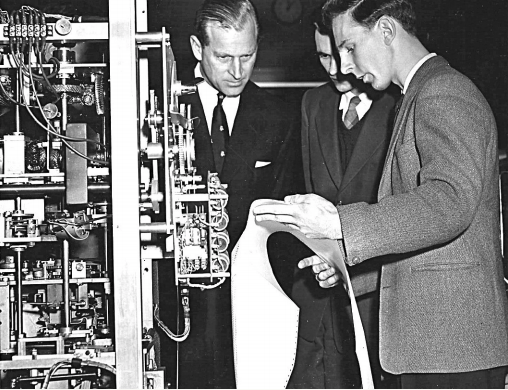
| Home > LEO Computers > LEOPEDIA > People > Tony Morgan |
Tony Morgan
|
Tony Morgan June 1937 - 4 April 2020 Tony Morgan played a key role in the commissioning of LEO II and LEO III systems. He went to Harrow County Grammar School and, after getting four A levels, joined the RAF, as his stint of National Service, where he was trained as an air radar fitter. When at school he had heard, on the radio, about the original Lyons collaboration with Cambridge and the first successful job being run. After demob he joined LEO Computers in 1957 as a trainee engineer and was moved to work on Leo II/1 at Elms House before completing the training course, progressing to shift leader. Advancement was to the Minerva Road factory where he worked on LEO II/5, the first machine with drums and magnetic tapes, which were to be his specialism over the years. He then commissioned LEO II/8, the first LEO machine with core store, for the UK motor manufacturer Standard Triumph. The Duke of Edinburgh visited the factory whilst Tony was working on this machine and talked to him (see photo, which shows Tony in 1960 showing the Duke of Edinburgh the printout from Powers Samastronic printer on LEO II/8, which was being set up. The person in the middle is Stan Holwill who was conducting that phase of his tour of the factory at Minerva Road.). Tony then moved to work on the pilot LEO III with Steve Farrow. It was a half-word machine to prove the new concepts incorporated in the machine: importantly, microprogramming and multi-programming with store protection. He then commissioned III/2 for Rand Mines, South Africa, and took it to Johannesburg, 6,000 miles from home, where he spent 6 weeks getting it tested and accepted by the customer. No emails then, just airmails; his record of this makes fascinating reading. LEO III/1 was still in the factory. (The second photo on this page shows Tony with gold ingot at a visit to Harmony Gold Mine, South Africa in 1962 whilst installing LEO III/2.) Years later David Caminer said that what Tony had achieved was incredible. On his return he commissioned III/5, the “shop window” machine for CAV in Acton that was visible from the pavement outside, and went on to III/9, the largest configuration yet with many magnetic tapes, for Customs and Excise in Southend. Tony took over management of Commissioning the LEO III range of what was by that time English Electric LEO in March 1964 and over the next four years expanded to a team of forty including twenty engineers and twelve operators together with supporting functions, using eight air-conditioned sites across two factory buildings. During this period, Tony led the introduction of the faster Leo 326 machines that initially went to the GPO (now BT) for telephone billing, one of the largest single computer orders ever at that time. In late 1967 Tony moved towards Product Planning, via a spell of systems support for customers during the changeover from English Electric to ICL. He was involved in product planning for elements of System 4, 1900, 2903 and then New Range (2900) where he sorted out the operating station, using David Caminer’s influence. After some time he re-joined Government Sales as a technical consultant looking at all the “red alerts” and major problem sites. This is where LEO came back on the scene. The GPO’s Charles House site in West Kensington now had four 326 systems with sixty magnetic tape decks of two types and there were big problems that led to the customer withholding maintenance charges (a lot of money). Tony instituted training for engineers, got the spares situation resolved, ensured that the tape system worked and that the engineers would keep them that way. He stayed with it until the rolling six month performance had returned to contractual level and the customer paid. He was awarded a Customer Satisfaction Award and joined what was by then ICL’s Post Office (Sales) Region to liaise with all their very many sites – Leo, System 4 and 2900 – he did that for several years. In the late 1970’s it became clear that the Post Office wasn’t redeveloping its billing system, from Leo, quickly enough and that the Leo machines would life expire before completion. He suggested that the Post Office should pay ICL to develop a DME/LEO (using a 2960 processor to implement the LEO microprograms as had been done with DME /System 4 and DME/1900). This was done at the ICL Scottish Development Centre in Dalkeith and Tony supplied them with the LEO microprogram flowcharts. When they were ready, he took the LEO engineering test programs to Scotland and within a week all were working and the Master Routine could then be loaded: another successful project that protected the customer and ICL’s interests, although it wasn’t extensively used. Again, his detailed record of this is lodged at CCH. His last working years were spent with Customer Service HQ in Putney and then Stevenage until he retired in 1995 after 38 years’ service. An Obituary for Tony Morgan was written by Frank Land and published in Other Lives, Guardian Newspaper online, May 7th, and on page 11 of the Journal section on June 4th 2020. An Appreciation of Tony Morgan's life and contribution to LEO was published in the Spring 2020 edition of LEO Matters, pp 14-15. Articles Written by Tony Morgan :
|
|











